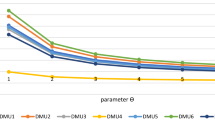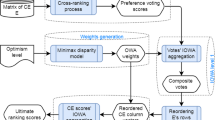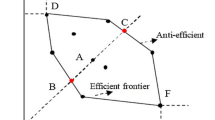Abstract
In spite of strong discrimination power, the cross-efficiency methods suffer from some drawbacks that may limit their usefulness. The possible existence of multiple optimal weights may lead to the non-uniqueness of cross-efficiency scores and rankings. Also, some of these methods evaluate decision making units (DMUs) according to an optimistic approach. In this approach, the strengths of DMUs are considered, whereas their weaknesses are ignored. To reflect the real performance of DMUs, both weaknesses and strengths of them must be considered. In this study, an optimistic–pessimistic approach is applied for presenting a new cross-efficiency method. In the proposed method, the estimated scores are based on both weaknesses and strengths of DMUs. Also, using the proposed models, the optimal weights are uniquely determined. So, the proposed method can fully rank DMUs without needing to any secondary goal. Finally, our method is illustrated using two examples.

Similar content being viewed by others
References
Alcaraz J, Ramón N, Ruiz JL, Sirvent I (2013) Ranking ranges in cross-efficiency evaluations. Eur J Oper Res 226:516–521
Charnes A, Cooper WW, Rhodes E (1978) Measuring the efficiency of DMUs. Eur J Oper Res 2:429–444
Doyle J, Green R (1994) Efficiency and cross-efficiency in DEA: derivations, meanings and uses. J Oper Res Soc 45(5):567–578
Khodabakhshi M, Aryavash K (2012) Ranking all units in data envelopment analysis. Appl Math Lett 25:2066–2070
Khodabakhshi M, Aryavash K (2014a) The fair allocation of common fixed cost or revenue using DEA concept. Ann Oper Res 214(1):187–194
Khodabakhshi M, Aryavash K (2014b) Ranking units with fuzzy data in DEA. Data Envel Anal Decis Sci 2014:1–10
Khodabakhshi M, Aryavash K (2014c) The global Malmquist productivity index under the optimistic–pessimistic approach of DEA. Int J Oper Res 11(4):131–137
Khodabakhshi M, Aryavash K (2015a) Aggregating preference rankings using an optimistic–pessimistic approach. Comput Ind Eng 85:13–16
Khodabakhshi M, Aryavash K (2015b) The optimistic–pessimistic ranking in the chance constrained DEA. Int J Oper Res 12:1–6
Khodabakhshi M, Rezaee M, Aryavash K (2015) ABC classification using DEA: classification of Iranian universities from students welfare foundation view point. Int J Inf Decis Sci 7(4):358–365
Liang L, Wu J, Cook WD, Zhu J (2008a) The DEA game cross-efficiency mode and its Nash equilibrium. Oper Res 56(5):1278–1288
Liang L, Wu J, Cook WD, Zhu J (2008b) Alternative secondary goals in DEA cross-efficiency evaluation. Int J Prod Econ 113:1025–1030
Lim S (2012) Minimax and maximin formulations of cross-efficiency in DEA. Comput Ind Eng 62:726–731
Ramón N, Ruiz JL, Sirvent I (2014) Dominance relations and ranking of units by using interval number ordering with cross-efficiency intervals. J Oper Res Soc 65:1336–1343
Sexton TR, Silkman RH, Hogan AJ (1986) Data envelopment analysis: critique and extensions. In: Silkman RH (ed) Measuring efficiency: an assessment of data envelopment analysis. Jossey-Bass, San Fransisco, pp 73–105
Wang YM, Chin KS (2010) A neutral DEA model for cross-efficiency evaluation and its extension. Expert Syst Appl 37(5):3666–3675
Wang YM, Chain KS, Jiang P (2011) Weight determination in the cross-efficiency evaluation. Comput Ind Eng 61:497–502
Wu J, Sun J, Liang L (2012) Cross efficiency evaluation method based on weight-balanced data envelopment analysis model. Comput Ind Eng 63:513519
Yang F, Ang S, Xia Q, Yang C (2012) Ranking DMUs by using interval DEA cross efficiency matrix with acceptability analysis. Eur J Oper Res 223:483–488
Zhu J (1998) Data envelopment analysis vs. principal component analysis: an illustrative study of economic performance of Chinese cities. Eur J Oper Res 111(1):5061
Author information
Authors and Affiliations
Corresponding author
Rights and permissions
About this article
Cite this article
Khodabakhshi, M., Aryavash, K. The cross-efficiency in the optimistic–pessimistic framework. Oper Res Int J 17, 619–632 (2017). https://doi.org/10.1007/s12351-016-0243-z
Received:
Revised:
Accepted:
Published:
Issue Date:
DOI: https://doi.org/10.1007/s12351-016-0243-z




